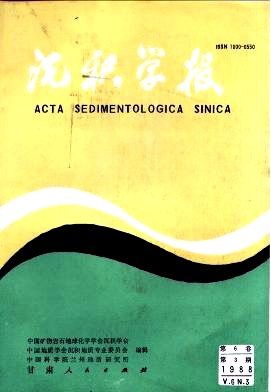RING D AROMATIZED 8,14-SECOHOPANES IN CRUDE OILS AND SOURCE ROCKSITS GEOCHEMICAL SIGNIFICANCE
- Received Date: 1986-08-08
- Publish Date: 1988-09-10
Abstract: Ring D aromatized 8,14-secohopanes ( C29-C30 ) and benzohopanes ( C32-C35 ) have been detected in particular abundance in the aromatic fractions of cru de oils a-nd source rocks from the western depression of Liao-He Basin.The variations of a-mount of both families with depth have been studied and showed that there are more benzohopanes in source rocks shallower than 2800m depth and more ring D aromatized 8,14-secohopanes deeper than 2800m. Both families are thought to be the products formed from bacterial hopanoid p-recursors. Benzohopanes are particularly abundant in immature source rocks. They might be formed directly from the C35 bacterial hopanol by chemical reaction atten-ed by microorganism in the early stage of sedimentation. With increasing tempreu-re, they can be easily destroyed, probably by cleavage of ring C which is unstable, to some of bicyclic terpanes or tricycloditerpanes and alfcylated indanes whitch occurring in crude oils and source rocks. Ring D aromatized 8,14-secohopanes do not appear until threshold. They may be formed from hopanoid precursors by aromatization cleavage of the fragile 8 (14) b-ond on ring C under thermol stress. Until 2800 M their amount is increasing. Fuct-her thermol stress would destroy this family, in particular by cleavage of 11(12) bond and side chain,both are fragile benzylic position,and yield some of bicyclic terpanes and alkylated indanes. The rate of destruction is lower than that of benzohopanes, probably due to the stable molecular structure of ring D aromatized 8,14-secohopanes which has one less 6-membered carbon ring than that of benzohopanes. In short, there are differances in the time and the rate of their formation and destruction. It is difficult to assum from their molecular structure that ring D aromatized 8, 14-secohpanes and benzohopanes can be transformed each other under thermol stress. But the ratio of (C29-C33)ring D aromatized 8, 14-secohopanes/(C29-C33 ring D aromatized 8, 14-secohopanes + C32-C35benzohopanes ) , MAH parameter briefly, can act as a powerful maturation parameter. MAH parameter increases steadily with increasing maturation. because of the differance in the time and the rate of formation and destruction of these two families. In our studied basin, the value of MAH parameter is 0.3-0.5 for upper oil-generating zone and 0.5-1.0 for lower oil-generating zone
| Citation: | Lu Songnian, Li Weimin, He Wei. RING D AROMATIZED 8,14-SECOHOPANES IN CRUDE OILS AND SOURCE ROCKSITS GEOCHEMICAL SIGNIFICANCE[J]. Acta Sedimentologica Sinica, 1988, 6(3): 41-49. |






 DownLoad:
DownLoad: